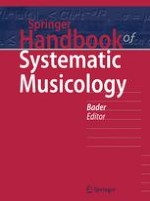2018 | OriginalPaper | Buchkapitel
24. Auditory Working Memory
verfasst von : Katrin Schulze, Stefan Koelsch, Victoria Williamson
Erschienen in: Springer Handbook of Systematic Musicology
Verlag: Springer Berlin Heidelberg
Aktivieren Sie unsere intelligente Suche, um passende Fachinhalte oder Patente zu finden.
Wählen Sie Textabschnitte aus um mit Künstlicher Intelligenz passenden Patente zu finden. powered by
Markieren Sie Textabschnitte, um KI-gestützt weitere passende Inhalte zu finden. powered by
